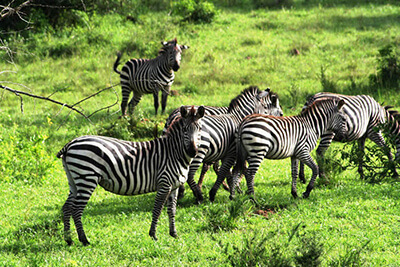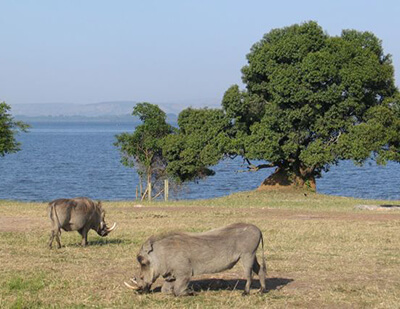Lake Mburo National Park in Western Uganda
Lake Mburo National Park is the largest of five lakes which, together with the surrounding wetlands, constituting 20% of the park’s surface of 260 square kilometres. But being only 260 square kilometres, makes it the smallest of Uganda’s savanna National Parks. This kind of nature makes this relatively park very ideal and interesting for bird watching (over 310 species) throughout the year.

Among the tourist places in western Uganda, Lake Mburo National Park, is a place which is so much interesting that every part of it is alive with variety, interest and colour contains an extensive area of wetland one of the only two such habitats to be included within a National Park in Uganda. It has mosaic habitat, dry hillside, rocky outcrops, bushes thickets, open and wooded savanna forests, lakes and swamps which homes to a surprising diversity of flora and fauna.
The park accommodates several species of mammals like a wider variety of antelopes Zebras, Impala, Buffaloes and many bird species including the bill storks which are found nowhere else in the country. Its landscape with rolling grassy hills and idyllic lake shore has a varied mosaic of habitats forest galleries, seasonal and permanent swamps and rich acacia wood valleys which all give a wealth of wildlife. It is the only place where the impala still occurs and it is the best place to see the eland, Africa’s largest antelope. Bigger buffalo and zebra herds are common in this park. With our professional tour guides, no doubt you will see more of these attractions.
Tourist Activities in Lake Mburo National Park
The Park, among Uganda’s tourist places is among the country’s loveliest destinations wildlife safaris and very ideal for game drives, Birding safaris, forest walks (walking in Rubanga forest), foot safaris (guided nature walks), boat trips, fishing, salt licks as well as sport hunting.
Bird Watching
Lake Mburo National Park has about 313 various bird species comprising of the rare Shoebill stork and White-winged Warbler. Other bird species are the Crested Francolin, common Quails, Emerald-spotted Wood Dove, Greenwood Hoopoe, Brown Parrot, Barefaced Go-away bird, Blue-naped Mousebird, Red necked Spur, Black-billed Barbet, Lilac-breasted Roller, African-grey Hornbill, Nubian Woodpecker, Trilling Cisticola a drive towards Rwonyo camp may show Coqui Francolin, Red necked spurfowl, Black Bellied Bustard, Temminck’s Courser, African-wattled Plover, Rufous naped and Flappet lark, Rufous chested Swallow, Yellow-throated Longclaw and Southern Red Bishop.
Hiking and Nature Walks in Lake Mburo
Hiking and Nature Walks in Lake Mburo usually begin in the morning and take 2 hours with an escorting ranger.
Extraordinarily, the park is openly accessible by strollers who are accompanied by a ranger guide. From Rwonyo, a guided nature walk takes you to a salt lick area where lots of animals are enticed to the saline rocks.
Nature Strides on the park’s western segment start at 7:00 am and last for two hours. During this walk, you may encounter hyenas coming back to their retreats and hippos receding to the lake. Treks through the forest offer a chance to see jungle birds plus mammals. And the march to the uppermost level of the hill prizes guests with a remarkable sighting of the 9 of the area’s 14 lakes. Rubanga Forest is a perfect spot for walkers and birders and visiting it requires prior arrangement with a ranger on the entourage.
Boat trips
 Lake Mburo has wealth of fauna and flora species view-able properly from a boat ride starting from a lakeside campsite near Rwonyo. The crocodiles, hippopotamuses and birds like pelicans, black crake, heron, Cormorant, Fish Eagle and the rare shoebill stork among the fauna that can be seen in a two-hour boat voyage. The duration of each boat cruise is negotiable with the park management.
Lake Mburo has wealth of fauna and flora species view-able properly from a boat ride starting from a lakeside campsite near Rwonyo. The crocodiles, hippopotamuses and birds like pelicans, black crake, heron, Cormorant, Fish Eagle and the rare shoebill stork among the fauna that can be seen in a two-hour boat voyage. The duration of each boat cruise is negotiable with the park management.
Salt Lick Guided walks
With these walks, you will explore the park around Rwonyo, leading to a visit to a natural salt lick frequented by wildlife. This kind of viewing is facilitated by a timber observation platform. From a wooden platform visitors have got an opportunity to see at least four different species of animals at any one time as they lick the salty soil. This is done to he animal’s unawareness since the wooden platform works as a hideaway.
Nature trail
With this trail, a tourist gets an opportunity to appreciate the nature, walking with utmost freedom in the company of an armed guide.
Fishing
The lake has about six fish species, common there include tilapia, lungfish, mud fish, haplochromis and others fished out of water using of hooks. Shades for relaxation for visitors are offered at the campsite near the lake.
Accommodations around Lake Mburo National Park
The park has accommodation facilities in form of tents at Rwonyo park headquarters and at three public campsites. Another luxury accommodation is at the tented Mantana Luxury Camp, Mihingo Lodge, Lake Mburo Safari Lodge and Rwakobo Rock Hotel. Travelers from Kampala can make a stopover and sleep at the various Masaka Hotels or those coming from western Uganda can stay in Mbarara town after leaving or before proceeding to the national park.
Lake Mburo National Park in western Uganda is one of the 10 national parks in Uganda. Positioned on the road to all the major parks and tourist places in western Uganda, Lake Mburo has got a few lodges for accommodation purposes. Tourists to this small park enjoy their stay at very friendly rates. Lake Mburo lodges for accommodation purpose while on safaris include:-
-
Mihingo Lodge
-
Mburo Safari Lodge
-
Mantana Tented Camp
-
Arcadia Cottages Lake Mburo
-
Rwakobo Rock Hotel
-
Rwonyo Rest Camp
How Many Lakes are in Lake Mburo National Park?
How many game parks are in Uganda?
Uganda has 10 National Parks distributed in various parts of the country. These national parks are homes to a wide variety of mammals and bird species. And among them, Murchison Falls National Park is the biggest of all, followed by Queen Elizabeth National Park. And Semuliki Valley National Park appears on the list of game parks in Uganda as the smallest.
Getting to Lake Mburo National Park
Lake Mburo National Park is in Mbarara district. It a 3-4 hours drive from Kampala on Mbarara-Kampala highway. Then turn left at 13 km at Akageti after Lyantonde town bringing you to Sanga gate. The road is tarmac from Kampala with some comfort. Another drive of 13 kms from Sanga trading center of Sanga gate, then 5 kms from the main road to Nshara gate and a 20-minute drive from Rwonyo Park Headquarters.
